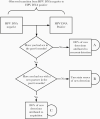Rates of New Human Papillomavirus Detection and Loss of Detection in Middle-aged Women by Recent and Past Sexual Behavior
- PMID: 32870982
- PMCID: PMC8064050
- DOI: 10.1093/infdis/jiaa557
Rates of New Human Papillomavirus Detection and Loss of Detection in Middle-aged Women by Recent and Past Sexual Behavior
Abstract
Background: Understanding the source of newly detected human papillomavirus (HPV) in middle-aged women is important to inform preventive strategies, such as screening and HPV vaccination.
Methods: We conducted a prospective cohort study in Baltimore, Maryland. Women aged 35-60 years underwent HPV testing and completed health and sexual behavior questionnaires every 6 months over a 2-year period. New detection/loss of detection rates were calculated and adjusted hazard ratios were used to identify risk factors for new detection.
Results: The new and loss of detection analyses included 731 women, and 104 positive for high-risk HPV. The rate of new high-risk HPV detection was 5.0 per 1000 woman-months. Reporting a new sex partner was associated with higher detection rates (adjusted hazard ratio, 8.1; 95% confidence interval, 3.5-18.6), but accounted only for 19.4% of all new detections. Among monogamous and sexually abstinent women, new detection was higher in women reporting ≥5 lifetime sexual partners than in those reporting <5 (adjusted hazard ratio, 2.2; 95% confidence interval, 1.2-4.2).
Conclusion: Although women remain at risk of HPV acquisition from new sex partners as they age, our results suggest that most new detections in middle-aged women reflect recurrence of previously acquired HPV.
Keywords: cervical cancer screening; cervical neoplasia; epidemiology; human papillomavirus; sexual behavior.
© The Author(s) 2020. Published by Oxford University Press for the Infectious Diseases Society of America. All rights reserved. For permissions, e-mail: journals.permissions@oup.com.
Figures



Similar articles
-
Contributions of recent and past sexual partnerships on incident human papillomavirus detection: acquisition and reactivation in older women.Cancer Res. 2012 Dec 1;72(23):6183-90. doi: 10.1158/0008-5472.CAN-12-2635. Epub 2012 Sep 27. Cancer Res. 2012. PMID: 23019223 Free PMC article.
-
Prospective follow-up of 2,065 young unscreened women to study human papillomavirus incidence and clearance.Int J Cancer. 2013 Jul;133(1):172-81. doi: 10.1002/ijc.27986. Epub 2013 Mar 7. Int J Cancer. 2013. PMID: 23233366
-
Proportion of Incident Genital Human Papillomavirus Detections not Attributable to Transmission and Potentially Attributable to Latent Infections: Implications for Cervical Cancer Screening.Clin Infect Dis. 2022 Aug 31;75(3):365-371. doi: 10.1093/cid/ciab985. Clin Infect Dis. 2022. PMID: 34849640 Free PMC article.
-
Incident Detection of High-Risk Human Papillomavirus Infections in a Cohort of High-Risk Women Aged 25-65 Years.J Infect Dis. 2016 Sep 1;214(5):665-75. doi: 10.1093/infdis/jiw074. Epub 2016 Mar 23. J Infect Dis. 2016. PMID: 27009602 Free PMC article.
-
Viral load and short-term natural history of type-specific oncogenic human papillomavirus infections in a high-risk cohort of midadult women.Int J Cancer. 2014 Apr 15;134(8):1889-98. doi: 10.1002/ijc.28509. Epub 2013 Oct 18. Int J Cancer. 2014. PMID: 24136492 Free PMC article.
Cited by
-
HPV vaccination among seropositive, DNA negative cohorts: a systematic review & meta-analysis.J Gynecol Oncol. 2022 May;33(3):e24. doi: 10.3802/jgo.2022.33.e24. Epub 2022 Jan 12. J Gynecol Oncol. 2022. PMID: 35128855 Free PMC article.
-
It's time to re-evaluate cervical Cancer screening after age 65.Gynecol Oncol. 2021 Jul;162(1):200-202. doi: 10.1016/j.ygyno.2021.04.027. Epub 2021 Apr 26. Gynecol Oncol. 2021. PMID: 33926748 Free PMC article. Review.
-
HPV and vaginal microecological disorders in infertile women: a cross-sectional study in the Chinese population.Virol J. 2022 Aug 25;19(1):137. doi: 10.1186/s12985-022-01869-0. Virol J. 2022. PMID: 36008847 Free PMC article.
-
High rate of persistent HPV detection after diagnostic cervical excision in older screen-positive women.Acta Obstet Gynecol Scand. 2025 Feb;104(2):342-349. doi: 10.1111/aogs.15019. Epub 2025 Jan 2. Acta Obstet Gynecol Scand. 2025. PMID: 39745094 Free PMC article.
-
The human Papillomavirus twilight zone - Latency, immune control and subclinical infection.Tumour Virus Res. 2023 Dec;16:200268. doi: 10.1016/j.tvr.2023.200268. Epub 2023 Jun 23. Tumour Virus Res. 2023. PMID: 37354969 Free PMC article. Review.
References
-
- Syrjänen K, Hakama M, Saarikoski S, et al. . Prevalence, incidence, and estimated life-time risk of cervical human papillomavirus infections in a nonselected Finnish female population. Sex Transm Dis 1990; 17:15–9. - PubMed
-
- Bruni L, Diaz M, Castellsagué X, Ferrer E, Bosch FX, de Sanjosé S. Cervical human papillomavirus prevalence in 5 continents: meta-analysis of 1 million women with normal cytological findings. J Infect Dis 2010; 202:1789–99. - PubMed
-
- Burchell AN, Winer RL, de Sanjosé S, Franco EL. Chapter 6: epidemiology and transmission dynamics of genital HPV infection. Vaccine 2006; 24(suppl 3):52–61. - PubMed
-
- Schiffman M, Castle PE, Jeronimo J, Rodriguez AC, Wacholder S. Human papillomavirus and cervical cancer. Lancet 2007; 370:890–907. - PubMed
Publication types
MeSH terms
Grants and funding
LinkOut - more resources
Full Text Sources
Medical
Miscellaneous

